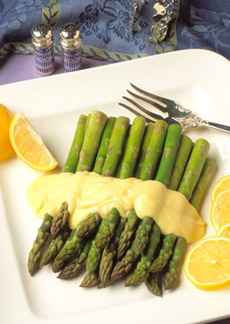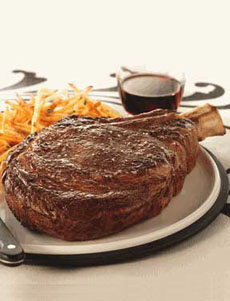TIP OF THE DAY: Moist Vs. Dry Cooking Methods
|
You cook a rib-eye steak with dry heat. Here |
Today, Chef Johnny Gnall provides some tips on moist versus dry cooking. His report follows. If you have questions or suggestions for tips, email Chef Johnny. All cooking methods are not created equal. Each has its time and place, but they are not interchangeable. You certainly wouldn’t boil a ribeye steak, and I hope you wouldn’t try to deep fry spinach. Different foods require different levels of heat to cook, as well as different methods by which that heat is applied. Straying too far from the ideal method can leave you with dried-out fish, mushy vegetables or chewy meat. MOIST VS. DRY COOKING METHODS: HOW, Cooking methods are generally split into two categories: moist heat and dry heat. Within these groupings there are a number of methods with varying degrees of intensity and specific vehicles, and each comes with its own set of limits. |
|
|
What follows is a comprehensive breakdown of each cooking method, its ideal uses and things to keep in mind when applying it. These are by no means unbreakable rules. No doubt, culinary masterpieces have been created by thinking outside the box (or the pot, the oven, the grill…). But they’re good guidelines for a home cook to follow. MOIST COOKING METHODS BOILING is one of the harshest methods of cooking. It is typically limited to dense and hearty foods like potatoes or other root vegetables. Boiling something more delicate, like a zucchini, would most likely reduce it to smithereens, both from the heat and the agitation from the bubbles. BLANCHING, though still performed in boiling water, is typically done for a shorter, punctuated amount of time, and then immediately followed by an ice bath. Asparagus, for example, is typically blanched for three to four minutes; the ice bath helps it keep its vibrant green color (you can always gently reheat the vegetables later). Blanching is a great way to get an exact amount of doneness while preserving attractiveness. SIMMERING is achieved when you see small bubbles consistently rising to the surface of a liquid on the stove (as opposed to the large bubbles of boiling). This is typically the way to reduce sauces and cook soups. Simmering allows you to achieve high temperatures in your broth or sauce, but is more gentle than boiling. You usually have to play with the heat to get a simmer just right, so be patient. Even once you think you have it nailed, watch your pot for a minute to make sure. POACHING is officially achieved between 160°F and 180°F. Tiny bubbles form at the bottom of the pan and rise intermittently to the surface. Poaching is the way to go for particularly delicate items like a poached egg. Most fish or seafood that are cooked in liquid are typically poached. |
||
|
BRAISING is a wonderful way to cook meats and hearty vegetables. The food is covered about three quarters of the way with liquid; the liquid is used to both cook and flavor the dish. Braised meats become pull-it-apart tender and are infused with all the aromatics of whatever they are cooked in. The technique creates wonderfully complex flavor profiles in both the braising liquid and the meat and vegetables. After the food is cooked, you can continue to reduce the braising liquid at a simmer to concentrate the flavor and create killer sauces.
STEWING is simply braising a variety of different foods together. The most familiar is perhaps a combination of potatoes, carrots, onions and parsnips, and a braised meat, cooked together. STEAMING is arguably the most delicate cooking method, and ideal for most vegetables. Bamboo steamers are cheap, long-lasting and easy to use, and many stock pots also come with a steamer insert. Simply boil water, place food in the steamer and cover. Vegetables typically take two to five minutes or so. Steaming is extremely healthy as it uses no fat and leeches the least amount of nutrients from the food. |
 Asparagus is blanched, then treated to an ice bath. It can be warmed briefly in the microwave before saucing (here, with Hollandaise sauce) and serving. Photo courtesy California Asparagus Commission. |
|
|
SAUTÉING utilizes a wide pan (what some might call a “frying pan”) and a bit of fat, typically butter or oil. You want just enough fat to cover the bottom of the pan and conduct heat to evenly cook the food, but not so much that the meat or vegetables are soaking in it. Sautéing is usually done best by starting on high heat, getting the pan very hot to achieve a nice sear, and then lowering the heat. PAN FRYING also involves a frying pan, but one with high sides to control spattering. Fill the pan with 1-2 inches of oil and, with the pan set over medium high heat, get the oil to the point at which a pinch of flour instantly sizzles. This type of cooking works well for croquettes as long as you roll them around to cook evenly; and for anything thin or short, like a breaded fish filet or veal scallops. DEEP FRYING is pretty much what it sounds like. You’ll need a pot with high sides (I like to use a stock pot) and a candy thermometer. You need to keep the oil between 325°F and 375°F, depending on what you’re frying; it may take some patience and fiddling with the flame. Three to six inches of oil should work with most foods; but as a general rule of thumb, make sure the food can sit submerged with about an inch of oil above and below it. With almost everything you deep fry, golden-brown and crispy is a pretty good indicator of doneness. It’s often a good idea to drop a tester of whatever you’re frying (one piece, tossed in at the beginning) to get a good sense of frying time. DRY COOKING METHODS ROASTING & BAKING Roasting and baking are the same thing: cooking in an oven. The former label is typically used in savory cooking and the latter in pastry; the rest is semantics. Baking is arguably the driest of dry heats, so keep that in mind when deciding what kind of food you will cook in the oven. While most anything can cook at 350°F—from meats to casseroles to veggies—higher heat will often help form color and crispness. Keep an eye on things, though, as foods cooked at higher heat can dry out over longer periods of time. BROILING is cooking under very high, direct heat. This is often a way to finish a dish covered in cheese (think French onion soup), as the intense heat quickly gets the cheese brown and bubbly. You can also cook thinner cuts of meat and fish, like flank steak, under a broiler. If you watch them carefully, starting at 10 minutes or so, broiling large-diced raw potatoes tossed in oil can produce a nice, caramelized crust that gives way to a soft inside. Beware the broiler, however, as it may not be in top shape in older ovens and can be difficult to control, leaving you with burnt food and a kitchen full of smoke. GRILLING Ah, grilling: Synonymous with summertime barbecues, grilling is the absolute best way to give your food a rustic, pleasantly charred accent. I will always go with wood or charcoal over gas, as you often get more smokiness from the actual burning matter. To get perfect grill marks, make sure your grill is searing hot and well conditioned with oil, then place your product on it, pressing gently to ensure its surface is flush. Wait about ninety seconds (or less if you’re grilling something more delicate like vegetables), then rotate it 90 degrees. Wait about a minute, then flip and repeat. Are you inspired? Pick a different technique every night and go through them all.
|
||



